- What is a Blog
- What is Blog – Blogger Help
- Difference between Blog and Website
- Blogs Aren’t Necessarily Personal
- What is a Feed
- How to Use this Blog
ii. Subscribe in a Feed Reader
iii. Categories or Labels
What is a Blog?
A blog (weblog or web log) is much more casual, less stuffy than a traditional 'business' website. It is more conversational and in the moment than a static site. Source
A blog is a type of website that is usually arranged in chronological order from the most recent ‘post’ (or entry) at the top of the main page to the older entries towards the bottom. Source
Anyone can be a blogger. Blogger is the one who publishes posts (articles).
A Blog is a free expression of common men. Blog can be based on any topic. Blog is for everybody.
Blogger help says
Introduction
A blog is a personal diary. A daily pulpit. A collaborative space. A political soapbox. A breaking-news outlet. A collection of links. Your own private thoughts. Memos to the world.
Your blog is whatever you want it to be. There are millions of them, in all shapes and sizes, and there are no real rules.
In simple terms, a blog is a web site, where you write stuff on an ongoing basis. New stuff shows up at the top, so your visitors can read what's new. Then they comment on it or link to it or email you. Or not.
Publish your thoughts
A blog gives you your own voice on the web. It's a place to collect and share things that you find interesting— whether it's your political commentary, a personal diary, or links to web sites you want to remember.
Many people use a blog just to organize their own thoughts, while others command influential, worldwide audiences of thousands. Professional and amateur journalists use blogs to publish breaking news, while personal journalers reveal inner thoughts.
Whatever you have to say, Blogger can help you say it.
Engage your friends
Blogging is about more than just putting your thoughts on the web. It's about connecting with and hearing from anyone who reads your work and cares to respond. With Blogger, you control who can read and write to your blog — let just a few friends or the entire world see what you have to say!
Blogger Comments let anyone, anywhere, offer feedback on your posts. You can choose whether you want to allow comments on a post-by-post basis, and you can delete any comments you don't like.
Access Controls let you decide who can read and who can write to your blog. You can use a group blog with multiple authors as an excellent communication tool for small teams, families and other groups. Or as a single author, you can create a private online space for collecting news, links, and ideas, to keep to yourself or share with as many readers as you want.
Blogger Profiles let you find people and blogs that share your interests. Your Blogger Profile, where you can list your blogs, your interests, and more, lets people find you (but only if you want to be found).
Difference between a Blog and a Website
| Blog | Website |
| Easy to setup and design a blog. Even a non-technical person can setup a blog. No Technical knowledge is necessary. | More difficult for non-technical. Technical knowledge of coding is necessary. |
| A blog is much more casual, less stuffy than a traditional 'business' website. It is more conversational and in the moment than a static site. | Has a professional look and feel and approach. |
| Not well organized. | Well-organized. |
| Info is not easy to find | Info is easy to find. Websites are designed keeping this parameter in consideration. |
| Regularly or frequently updated | May or may not be regularly updated. Generally less frequently updated. |
| Very easy to post articles | Needs a professional approach |
| Anyone can be a blogger. | Not for everybody |
| More interactive with readers. Has “comments”, with which any reader can give his thoughts on the article. | Less interactive than blog. |
| Covers a wider area | Does not cover as wider area as a blog |
| Whenever a blog is updated, it can be known be it’s reader by the feature of Feeds. | Usually no such communication is made with the readers |
| New post or updates of your Blog will appear in Search Engines very, very quickly. Usually within minutes. | Takes time for new pages to be recognised by search spiders and so are not available in search engines immediately. |
| Big hearted techies offer high help in blog customization, features for free | Very less help available for Free. |
Blogs Aren’t Necessarily Personal
The main misconception regarding the definition of blogs comes from people that associate blogs with their content. More specifically from people that associate blogs with the content from one particular type of blog: personal blogs.
In other words, those people think that blogs are online diaries where people share their opinions, ramblings and personal events.
Wrong!
That is just one of the things that you could do with a blog.
Today blogs are being used for all sorts of purposes. You have companies that use blogs to communicate and interact with customers and other stake holders. Newspapers that incorporated blogs to their main website to offer a new channel for their writers. Individuals that created a blog to share with the world their expertise on specific topics. And so on.
What is a Feed?
Introduction
Feeds let you receive messages from newspapers and other information sources on the Web. Rather than visiting a newspaper Web site checking for updates all the time, you can subscribe to the site's feed, and receive news summaries like you receive e-mail messages.
Subscribing to feeds
Correctly coded RSS and Atom feeds will be automatically recognized by the browser when linked from a page you visit. Browser will then display a small icon within the address field. Click the icon to subscribe to the feed.
The first time you subscribe to a feed, Feeds will be added to Opera's main menu, and a "Feeds" heading will appear in your Mail panel if you have set up one or more e-mail or news accounts.
You can also right-click the mail panel and select "Feeds" to access a subscription dialog.
All feeds that you subscribe to will be available in the Feeds menu.
Note that it may take a while for the server to send you the first feed items after you subscribe.
Managing feeds
Feed items are managed in the same way as e-mail messages and can be searched, forwarded by e-mail, and so forth.
Source: Opera 9.64 Browser Help on Feeds
How to Use this Blog (INDIASPIRITUALITY) – Blog Basics
Blogger Navbar
Blogger with Blog*spot domain name, by default has the Blogger Navbar. It has integrated search for the blog. So the search box in the Navbar searches the Blog. Most people do not know that the search in Navbar is for that particular Blog, so I have embedded another search box in the Horizontal Navbar. Just below the Blog Header.
Feed Icons
Feed icon in Address Bar
This is the Feed icon. RSS ot ATOM. Both work in the similar way. Don’t know much about the technical difference between the two. They follow different standards.
Subscribe in Feed Reader
This is similar to the feed icon in the address bar. RSS Feed is automatically detected by the browser. Incase it fails to detect then this text link can do the work.
Categories or Labels
These are the labels given for any posts. If you are only interested in one particular category or Label (e.g. Ramakrishna Kathamrita), then you can subscribe to the RSS of a single Label. So, whenever a post with label Ramakrishna Kathamrita is published, you will get an alert or a RSS feed in your Feed Reader.
Numbers in the bracket shows the no posts post with the corresponding Label.
Please note that one post can have more than one label. So the Sum of all the numbers after labels (e.g. Saints (18) ) will not be equal to the total number of Posts published.
Subscribe by Email
One can Subcribe to the Blog Posts by conventional Email. After subscribing, you will receive an email every 24 hours. The email contains all the posts within the 24 hours. If there are no posts published, you will not receive an email. Blog administrator can also change the settings the way email will be send, like the time and the hours. i.e. daily or weekly.
Table Of Contents (TOC)
TOC shows all the posts published in descending order. Latest post is on the top and the oldest at the bottom.
Sitemap
Sitemap shows all the posts.
Sitemap hack (hack does not mean a piracy), developed by Hans of Beautifulbeta and modified by Amanda of Blogger Buster, shows all the posts. The view can be sorted by clicking on the headers like Post Date, Labels and Post Title. Clicking two times will change the sorting order (i.e. descending to ascending) alphabetically.
Please note that the Sitemap shows all the posts, even that are in draft, so it shows repeated entries.
Happy Reading

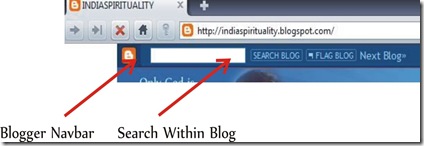

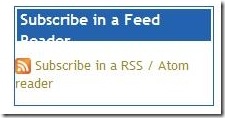
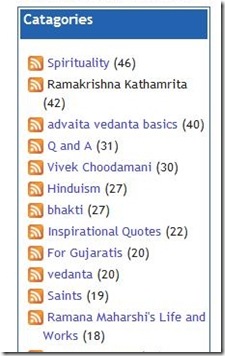
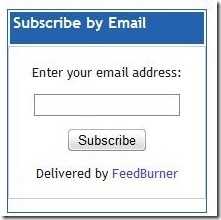
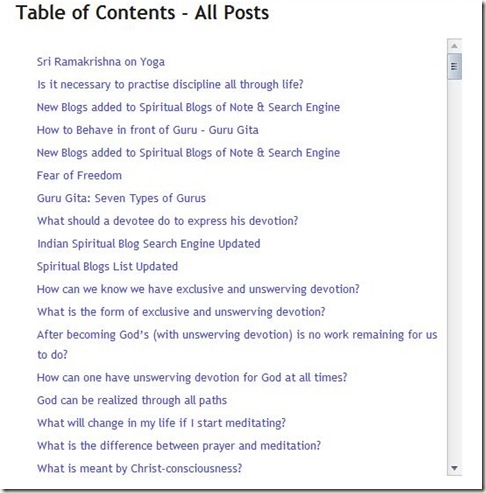

No comments:
Post a Comment